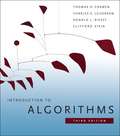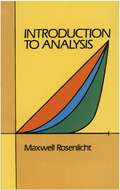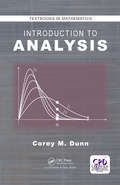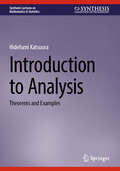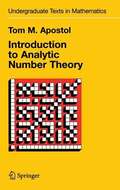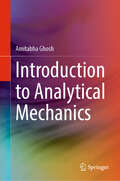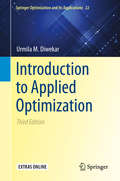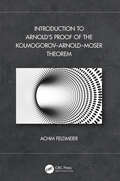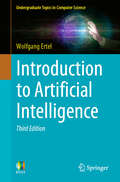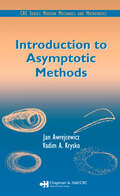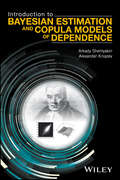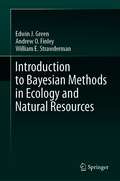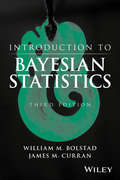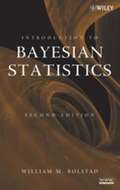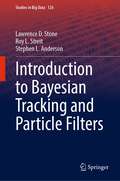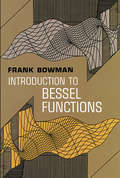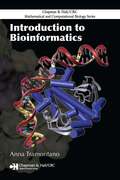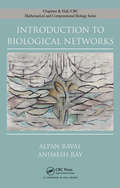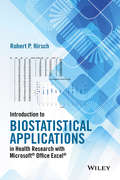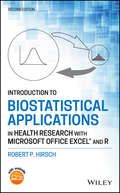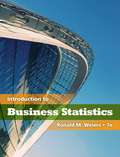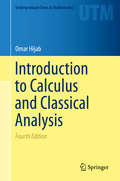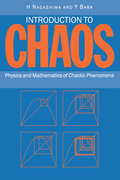- Table View
- List View
Introduction to Algorithms
by Clifford Stein Thomas H. Cormen Charles E. Leiserson Ronald L. RivestSome books on algorithms are rigorous but incomplete; others cover masses of material but lack rigor. Introduction to Algorithms uniquely combines rigor and comprehensiveness. The book covers a broad range of algorithms in depth, yet makes their design and analysis accessible to all levels of readers. Each chapter is relatively self-contained and can be used as a unit of study. The algorithms are described in English and in a pseudocode designed to be readable by anyone who has done a little programming. The explanations have been kept elementary without sacrificing depth of coverage or mathematical rigor.
Introduction to Analysis
by Maxwell RosenlichtWritten for junior and senior undergraduates, this remarkably clear and accessible treatment covers set theory, the real number system, metric spaces, continuous functions, Riemann integration, multiple integrals, and more. Rigorous and carefully presented, the text assumes a year of calculus and features problems at the end of each chapter. 1968 edition.
Introduction to Analysis (Textbooks in Mathematics)
by Corey M. DunnIntroduction to Analysis is an ideal text for a one semester course on analysis. The book covers standard material on the real numbers, sequences, continuity, differentiation, and series, and includes an introduction to proof. The author has endeavored to write this book entirely from the student’s perspective: there is enough rigor to challenge even the best students in the class, but also enough explanation and detail to meet the needs of a struggling student. From the Author to the student: "I vividly recall sitting in an Analysis class and asking myself, ‘What is all of this for?’ or ‘I don’t have any idea what’s going on.’ This book is designed to help the student who finds themselves asking the same sorts of questions, but will also challenge the brightest students." Chapter 1 is a basic introduction to logic and proofs. Informal summaries of the idea of proof provided before each result, and before a solution to a practice problem. Every chapter begins with a short summary, followed by a brief abstract of each section. Each section ends with a concise and referenced summary of the material which is designed to give the student a "big picture" idea of each section. There is a brief and non-technical summary of the goals of a proof or solution for each of the results and practice problems in this book, which are clearly marked as "Idea of proof," or as "Methodology", followed by a clearly marked formal proof or solution. Many references to previous definitions and results. A "Troubleshooting Guide" appears at the end of each chapter that answers common questions.
Introduction to Analysis: Theorems and Examples (Synthesis Lectures on Mathematics & Statistics)
by Hidefumi KatsuuraThis book focuses on the theoretical aspects of calculus. The book begins with a chapter on set theory before thoroughly discussing real numbers, then moves onto sequences, series, and their convergence. The author explains why an understanding of real numbers is essential in order to create a foundation for studying analysis. Since the Cantor set is elusive to many, a section is devoted to binary/ternary numbers and the Cantor set. The book then moves on to continuous functions, differentiations, integrations, and uniform convergence of sequences of functions. An example of a nontrivial uniformly Cauchy sequence of functions is given. The author defines each topic, identifies important theorems, and includes many examples throughout each chapter. The book also provides introductory instruction on proof writing, with an emphasis on how to execute a precise writing style.
Introduction to Analytic Number Theory (Undergraduate Texts in Mathematics)
by Tom ApostolThis book is the first volume of a two-volume textbook for undergraduates and is indeed the crystallization of a course offered by the author at the California Institute of Technology to undergraduates without any previous knowledge of number theory.
Introduction to Analytical Mechanics
by Amitabha GhoshThis comprehensive, introductory textbook on Analytical Mechanics is designed for both seasoned researchers and budding students of Mechanics. This book meticulously outlines the whole route to analytical treatment of the 'science of motion'. Authored with years of teaching expertise, this book unravels new concepts beyond the traditional Newtonian framework, ensuring clarity for beginners. The book is tailored to focus primarily upon areas essential in a first-level course. Unveil innovative treatments helpful in taking the first-time reader through the labyrinthian path along which often analytical mechanics progresses. Ideal for a semester-long study at senior undergraduate and junior postgraduate levels, our text features ample solved examples to reinforce theoretical applications.
Introduction to Applied Optimization (Springer Optimization and Its Applications #22)
by Urmila M. DiwekarProvides well-written self-contained chapters, including problem sets and exercises, making it ideal for the classroom setting; Introduces applied optimization to the hazardous waste blending problem; Explores linear programming, nonlinear programming, discrete optimization, global optimization, optimization under uncertainty, multi-objective optimization, optimal control and stochastic optimal control; Includes an extensive bibliography at the end of each chapter and an index; GAMS files of case studies for Chapters 2, 3, 4, 5, and 7 are linked to http://www.springer.com/math/book/978-0-387-76634-8; Solutions manual available upon adoptions.
Introduction to Arnold’s Proof of the Kolmogorov–Arnold–Moser Theorem
by Achim FeldmeierThis book provides an accessible step-by-step account of Arnold’s classical proof of the Kolmogorov–Arnold–Moser (KAM) Theorem. It begins with a general background of the theorem and proves the famous Liouville-Arnold theorem for integrable systems and introduces Kneser’s tori in four-dimensional phase space. It then introduces and discusses the ideas and techniques used in Arnold’s proof, before the second half of the book walks the reader through a detailed account of Arnold’s proof with all the required steps. It will be a useful guide for advanced students of mathematical physics, in addition to researchers and professionals. Key features: Applies concepts and theorems from real and complex analysis (e.g. Fourier series; implicit function theorem) and topology in the framework of this key theorem from mathematical physics. Covers all aspects of Arnold’s proof, including those often left out in more general or simplified presentations. Discusses, in detail, the ideas used in the proof of the KAM theorem and puts them in historical context (e.g. mapping degree from algebraic topology).
Introduction to Artificial Intelligence (Undergraduate Topics in Computer Science)
by Wolfgang ErtelThis accessible and engaging textbook presents a concise introduction to the exciting field of artificial intelligence (AI). The broad-ranging discussion covers the key subdisciplines within the field, describing practical algorithms and concrete applications in the areas of agents, logic, search, reasoning under uncertainty, machine learning, neural networks, and reinforcement learning. Fully revised and updated, this much-anticipated third edition also includes new material on deep learning.Topics and features:· Presents an application-focused and hands-on approach to learning, with supplementary teaching resources provided at an associated website · Introduces convolutional neural networks as the currently most important type of deep learning networks with applications to image classification (NEW) · Contains numerous study exercises and solutions, highlighted examples, definitions, theorems, and illustrative cartoons · Reports on developments in deep learning, including applications of neural networks to large language models as used in state-of-the-art chatbots as well as to the generation of music and art (NEW) · Includes chapters on predicate logic, PROLOG, heuristic search, probabilistic reasoning, machine learning and data mining, neural networks, and reinforcement learning · Covers various classical machine learning algorithms and introduces important general concepts such as cross validation, data normalization, performance metrics and data augmentation (NEW)· Includes a section on AI and society, discussing the implications of AI on topics such as employment and transportation Ideal for foundation courses or modules on AI, this easy-to-read textbook offers an excellent overview of the field for students of computer science and other technical disciplines, requiring no more than a high-school level of knowledge of mathematics to understand the material.Dr. Wolfgang Ertel is a professor at the Institute for Artificial Intelligence at the Ravensburg-Weingarten University of Applied Sciences, Germany.
Introduction to Asymptotic Methods
by David Y. Gao Vadim A. KryskoAmong the theoretical methods for solving many problems of applied mathematics, physics, and technology, asymptotic methods often provide results that lead to obtaining more effective algorithms of numerical evaluation. Presenting the mathematical methods of perturbation theory, Introduction to Asymptotic Methods reviews the most important m
Introduction to Banach Spaces: Analysis And Probability (Cambridge Studies in Advanced Mathematics #167)
by Daniel Li Hervé QueffélecThis two-volume text provides a complete overview of the theory of Banach spaces, emphasising its interplay with classical and harmonic analysis (particularly Sidon sets) and probability. The authors give a full exposition of all results, as well as numerous exercises and comments to complement the text and aid graduate students in functional analysis. The book will also be an invaluable reference volume for researchers in analysis. Volume 1 covers the basics of Banach space theory, operatory theory in Banach spaces, harmonic analysis and probability. The authors also provide an annex devoted to compact Abelian groups. Volume 2 focuses on applications of the tools presented in the first volume, including Dvoretzky's theorem, spaces without the approximation property, Gaussian processes, and more. Four leading experts also provide surveys outlining major developments in the field since the publication of the original French edition.
Introduction to Banach Spaces: Volume 1 (Cambridge Studies in Advanced Mathematics #166)
by Daniel Li Hervé QueffélecThis two-volume text provides a complete overview of the theory of Banach spaces, emphasising its interplay with classical and harmonic analysis (particularly Sidon sets) and probability. The authors give a full exposition of all results, as well as numerous exercises and comments to complement the text and aid graduate students in functional analysis. The book will also be an invaluable reference volume for researchers in analysis. Volume 1 covers the basics of Banach space theory, operatory theory in Banach spaces, harmonic analysis and probability. The authors also provide an annex devoted to compact Abelian groups. Volume 2 focuses on applications of the tools presented in the first volume, including Dvoretzky's theorem, spaces without the approximation property, Gaussian processes, and more. In volume 2, four leading experts also provide surveys outlining major developments in the field since the publication of the original French edition.
Introduction to Bayesian Estimation and Copula Models of Dependence
by Alexander Kniazev Arkady ShemyakinPresents an introduction to Bayesian statistics, presents an emphasis on Bayesian methods (prior and posterior), Bayes estimation, prediction, MCMC,Bayesian regression, and Bayesian analysis of statistical modelsof dependence, and features a focus on copulas for risk management Introduction to Bayesian Estimation and Copula Models of Dependence emphasizes the applications of Bayesian analysis to copula modeling and equips readers with the tools needed to implement the procedures of Bayesian estimation in copula models of dependence. This book is structured in two parts: the first four chapters serve as a general introduction to Bayesian statistics with a clear emphasis on parametric estimation and the following four chapters stress statistical models of dependence with a focus of copulas. A review of the main concepts is discussed along with the basics of Bayesian statistics including prior information and experimental data, prior and posterior distributions, with an emphasis on Bayesian parametric estimation. The basic mathematical background of both Markov chains and Monte Carlo integration and simulation is also provided. The authors discuss statistical models of dependence with a focus on copulas and present a brief survey of pre-copula dependence models. The main definitions and notations of copula models are summarized followed by discussions of real-world cases that address particular risk management problems. In addition, this book includes: • Practical examples of copulas in use including within the Basel Accord II documents that regulate the world banking system as well as examples of Bayesian methods within current FDA recommendations • Step-by-step procedures of multivariate data analysis and copula modeling, allowing readers to gain insight for their own applied research and studies • Separate reference lists within each chapter and end-of-the-chapter exercises within Chapters 2 through 8 • A companion website containing appendices: data files and demo files in Microsoft® Office Excel®, basic code in R, and selected exercise solutions Introduction to Bayesian Estimation and Copula Models of Dependence is a reference and resource for statisticians who need to learn formal Bayesian analysis as well as professionals within analytical and risk management departments of banks and insurance companies who are involved in quantitative analysis and forecasting. This book can also be used as a textbook for upper-undergraduate and graduate-level courses in Bayesian statistics and analysis. ARKADY SHEMYAKIN, PhD, is Professor in the Department of Mathematics and Director of the Statistics Program at the University of St. Thomas. A member of the American Statistical Association and the International Society for Bayesian Analysis, Dr. Shemyakin's research interests include informationtheory, Bayesian methods of parametric estimation, and copula models in actuarial mathematics, finance, and engineering. ALEXANDER KNIAZEV, PhD, is Associate Professor and Head of the Department of Mathematics at Astrakhan State University in Russia. Dr. Kniazev's research interests include representation theory of Lie algebras and finite groups, mathematical statistics, econometrics, and financial mathematics.
Introduction to Bayesian Methods in Ecology and Natural Resources
by William E. Strawderman Edwin J. Green Andrew O. FinleyThis book presents modern Bayesian analysis in a format that is accessible to researchers in the fields of ecology, wildlife biology, and natural resource management. Bayesian analysis has undergone a remarkable transformation since the early 1990s. Widespread adoption of Markov chain Monte Carlo techniques has made the Bayesian paradigm the viable alternative to classical statistical procedures for scientific inference. The Bayesian approach has a number of desirable qualities, three chief ones being: i) the mathematical procedure is always the same, allowing the analyst to concentrate on the scientific aspects of the problem; ii) historical information is readily used, when appropriate; and iii) hierarchical models are readily accommodated.This monograph contains numerous worked examples and the requisite computer programs. The latter are easily modified to meet new situations. A primer on probability distributions is also included because these form the basis of Bayesian inference.Researchers and graduate students in Ecology and Natural Resource Management will find this book a valuable reference.
Introduction to Bayesian Statistics
by William M. Bolstad James M. CurranThere is a strong upsurge in the use of Bayesian methods in applied statistical analysis, yet most introductory statistics texts only present frequentist methods. Bayesian statistics has many important advantages that students should learn about if they are going into fields where statistics will be used. In this Third Edition, four newly-added chapters address topics that reflect the rapid advances in the field of Bayesian staistics. The author continues to provide a Bayesian treatment of introductory statistical topics, such as scientific data gathering, discrete random variables, robust Bayesian methods, and Bayesian approaches to inferenfe cfor discrete random variables, bionomial proprotion, Poisson, normal mean, and simple linear regression. In addition, newly-developing topics in the field are presented in four new chapters: Bayesian inference with unknown mean and variance; Bayesian inference for Multivariate Normal mean vector; Bayesian inference for Multiple Linear RegressionModel; and Computational Bayesian Statistics including Markov Chain Monte Carlo methods.The inclusion of these topics will facilitate readers' ability to advance from a minimal understanding of Statistics to the ability to tackle topics in more applied, advanced level books. WinBUGS is discussed briefly in the coverage of Markov Chain Monte Carlo methods, and MiniTab macros and R functions are available on the book's related Web site to assist with chapter exercises.
Introduction to Bayesian Statistics
by William M. BolstadThe use of Bayesian methods in applied statistical analysis has become increasingly popular, yet most introductory statistics texts continue to only present the subject using frequentist methods. Introduction to Bayesian Statistics, Second Edition focuses on Bayesian methods that can be used for inference, and it also addresses how these methods compare favorably with frequentist alternatives. Teaching statistics from the Bayesian perspective allows for direct probability statements about parameters, and this approach is now more relevant than ever due to computer programs that allow practitioners to work on problems that contain many parameters.This book uniquely covers the topics typically found in an introductory statistics book--but from a Bayesian perspective--giving readers an advantage as they enter fields where statistics is used. This Second Edition provides:Extended coverage of Poisson and Gamma distributionsTwo new chapters on Bayesian inference for Poisson observations and Bayesian inference for the standard deviation for normal observationsA twenty-five percent increase in exercises with selected answers at the end of the bookA calculus refresher appendix and a summary on the use of statistical tablesNew computer exercises that use R functions and Minitab® macros for Bayesian analysis and Monte Carlo simulationsIntroduction to Bayesian Statistics, Second Edition is an invaluable textbook for advanced undergraduate and graduate-level statistics courses as well as a practical reference for statisticians who require a working knowledge of Bayesian statistics.
Introduction to Bayesian Tracking and Particle Filters (Studies in Big Data #126)
by Roy L. Streit Lawrence D. Stone Stephen L. AndersonThis book provides a quick but insightful introduction to Bayesian tracking and particle filtering for a person who has some background in probability and statistics and wishes to learn the basics of single-target tracking. It also introduces the reader to multiple target tracking by presenting useful approximate methods that are easy to implement compared to full-blown multiple target trackers.The book presents the basic concepts of Bayesian inference and demonstrates the power of the Bayesian method through numerous applications of particle filters to tracking and smoothing problems. It emphasizes target motion models that incorporate knowledge about the target’s behavior in a natural fashion rather than assumptions made for mathematical convenience.The background provided by this book allows a person to quickly become a productive member of a project team using Bayesian filtering and to develop new methods and techniques for problems the team may face.
Introduction to Bessel Functions (Dover Books on Mathematics)
by Frank BowmanA full, clear introduction to the properties and applications of Bessel functions, this self-contained text is equally useful for the classroom or for independent study. Topics include Bessel functions of zero order, modified Bessel functions, definite integrals, asymptotic expansions, and Bessel functions of any real order. More than 200 problems throughout.
Introduction to Bioinformatics (Chapman & Hall/CRC Mathematical and Computational Biology)
by Anna TramontanoGuiding readers from the elucidation and analysis of a genomic sequence to the prediction of a protein structure and the identification of the molecular function, Introduction to Bioinformatics describes the rationale and limitations of the bioinformatics methods and tools that can help solve biological problems. Requiring only a limited mathematical and statistical background, the book shows how to efficiently apply these approaches to biological data and evaluate the resulting information. The author, an expert bioinformatics researcher, first addresses the ways of storing and retrieving the enormous amount of biological data produced every day and the methods of decrypting the information encoded by a genome. She then covers the tools that can detect and exploit the evolutionary and functional relationships among biological elements. Subsequent chapters illustrate how to predict the three-dimensional structure of a protein. The book concludes with a discussion of the future of bioinformatics. Even though the future will undoubtedly offer new tools for tackling problems, most of the fundamental aspects of bioinformatics will not change. This resource provides the essential information to understand bioinformatics methods, ultimately facilitating in the solution of biological problems.
Introduction to Biological Networks
by Alpan Raval Animesh RayThe new research area of genomics-inspired network biology lacks an introductory book that enables both physical/computational scientists and biologists to obtain a general yet sufficiently rigorous perspective of current thinking. Filling this gap, Introduction to Biological Networks provides a thorough introduction to genomics-inspired network bi
Introduction to Biostatistical Applications in Health Research with Microsoft Office Excel
by Robert P. HirschA practical and methodological approach to the statistical logic of biostatistics in the field of health research Focusing on a basic understanding of the methods and analyses in health research, Introduction to Biostatistical Applications in Health Research with Microsoft® Office Excel® provides statistical concepts for interpreting results using Excel. The book emphasizes the application of methods and presents the most common methodological procedures in health research, which includes multiple regression, ANOVA, ANCOVA, logistic regression, Cox regression, stratified analysis, life table analysis, and nonparametric parallels. The book is constructed around a flowchart that outlines the appropriate circumstances for selecting a method to analyze a specific set of data. Beginning with an introduction to the foundational methods of statistical logic before moving on to more complex methods, Introduction to Biostatistical Applications in Health Research with Microsoft® Office Excel® also includes: Detailed discussions of how knowledge and skills in health research have been integrated with biostatistical methods Numerous examples with clear explanations that use mostly real-world health research data in order to provide a better understanding of the practical applications Implements Excel graphic representations throughout to help readers evaluate and analyze individual results An appendix with basic information on how to use Excel A companion website with additional Excel files, data sets, and homework problems as well as an Instructor's Solutions Manual Introduction to Biostatistical Applications in Health Research with Microsoft® Office Excel® is an excellent textbook for upper-undergraduate and graduate-level courses in biostatistics and public health. In addition, the book is an appropriate reference for both health researchers and professionals.
Introduction to Biostatistical Applications in Health Research with Microsoft Office Excel and R
by Robert P. HirschThe second edition of Introduction to Biostatistical Applications in Health Research delivers a thorough examination of the basic techniques and most commonly used statistical methods in health research. Retaining much of what was popular with the well-received first edition, the thoroughly revised second edition includes a new chapter on testing assumptions and how to evaluate whether those assumptions are satisfied and what to do if they are not. The newest edition contains brand-new code examples for using the popular computer language R to perform the statistical analyses described in the chapters within. You’ll learn how to use Excel to generate datasets for R, which can then be used to conduct statistical calculations on your data. The book also includes a companion website with a new version of BAHR add-in programs for Excel. This new version contains new programs for nonparametric analyses, Student-Newman-Keuls tests, and stratified analyses. Readers will also benefit from coverage of topics like: Extensive discussions of basic and foundational concepts in statistical methods, including Bayes’ Theorem, populations, and samples A treatment of univariable analysis, covering topics like continuous dependent variables and ordinal dependent variables An examination of bivariable analysis, including regression analysis and correlation analysis An analysis of multivariate calculations in statistics and how testing assumptions, like assuming Gaussian distributions or equal variances, affect statistical outcomes Perfect for health researchers of all kinds, Introduction to Biostatistical Applications in Health Research also belongs on the bookshelves of anyone who wishes to better understand health research literature. Even those without a great deal of mathematical background will benefit greatly from this text.
Introduction to Business Statistics (Seventh Edition)
by Ronald M. WeiersThis proven, popular text cuts through the jargon to help you understand fundamental statistical concepts and why they are important to you, your world, and your career. The text's outstanding illustrations, friendly language, non-technical terminology, and current, real-world examples will capture your interest and prepare you for success right from the start.
Introduction to Calculus and Classical Analysis
by Omar HijabThis text is intended for an honors calculus course or for an introduction to analysis. Involving rigorous analysis, computational dexterity, and a breadth of applications, it is ideal for undergraduate majors. This third edition includes corrections as well as some additional material. Some features of the text include: The text is completely self-contained and starts with the real number axioms; The integral is defined as the area under the graph, while the area is defined for every subset of the plane; There is a heavy emphasis on computational problems, from the high-school quadratic formula to the formula for the derivative of the zeta function at zero; There are applications from many parts of analysis, e. g. , convexity, the Cantor set, continued fractions, the AGM, the theta and zeta functions, transcendental numbers, the Bessel and gamma functions, and many more; Traditionally transcendentally presented material, such as infinite products, the Bernoulli series, and the zeta functional equation, is developed over the reals; and There are 385 problems with all the solutions at the back of the text.
Introduction to Chaos: Physics and Mathematics of Chaotic Phenomena
by H NagashimaThis book focuses on explaining the fundamentals of the physics and mathematics of chaotic phenomena by studying examples from one-dimensional maps and simple differential equations. It is helpful for postgraduate students and researchers in mathematics, physics and other areas of science.
